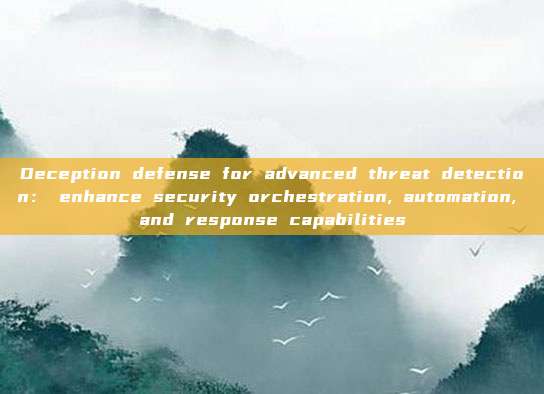Cybercrime is constantly evolving, and with the advancement of technology, the strategies adopted by global cybercriminals are also constantly evolving. Today's attackers use artificial intelligence and machine learning technologies to carry out attacks, which greatly increases the complexity and speed of attacks. Fortunately, it is not only cybercriminals who can take advantage of automated processes. Defenders must adopt effective automated measures to deal with increasingly complex attacks. At the same time, cybersecurity teams also need to seek corresponding countermeasures, such as investing in purchasing security tools related to event detection, analysis, and response to alleviate the manual workload.


Automated threat detection tools
Today, the number of security tools integrated with automation features to attempt to identify attacks has significantly increased, most of which use different levels of artificial intelligence for pattern matching or detecting abnormal behaviors. This feature is very useful for accelerating detection, but security teams have found that this method has certain flaws, it requires baselines and time for continuous optimization and improvement. Moreover, throughout the process, the number of false positives generated may cause the time saved previously to be wasted again.
To improve efficiency, security teams have started to use machine learning to automatically deploy security solutions.Deception technologyThis is an example of a technology that can self-learn the environment and then automatically propose lure configurations and credentials, which can make the deceptive lure perfectly integrate into the user's real environment. This automatic configuration saves deployment time and reduces the possible errors that may occur during customization.
Enhancing the automatic response capability of detection tools
Reducing the dwell time (the time between an intruder entering the network and the organization detecting the intrusion) can limit the potential damage that an attacker may cause. However, most detection tools today will only issue an alert when encountering real-time attacks. Because they cannot solve the attacker, they can only collect limited information about the attacker. After that, the security team will conduct an investigation manually, obtain credible attack intelligence, and associate attack data for classification. This is a complex task, and investigators need to study various logs and tools, search for indicators of compromise (IOCs), and collect more information to determine the source and extent of the attack.
By collecting relevant information at the time of the attack, organizations can gain many benefits.
- Drawing charts of attack starting points and paths can provide valuable information, such as determining the tools used by the attacker and even exploring their attack targets and intentions.
- If information is manually collected from attacks, and the necessary intelligence is derived through correlation, it may require a considerable amount of time and effort.
Fortunately, now the security controls within the network can automatically perform this function, providing defenders with high-fidelity alerts and verified high-quality information, enabling them to respond to events more quickly and effectively.
One method for collecting and correlating such information is to use Security Information and Event Management (SIEM). When log data is available and the system is appropriately adjusted, this method will be very convenient and efficient. Endpoint Detection and Response (EDR) solutions can also help provide endpoint forensics and other遥测 information. They can also isolate infected systems to mitigate the spread of attacks.
Another preferred control method is deception technology, as it can identify TTPs, IOCs, and other attack information. Security teams can use this information to automatically perform attack data analysis and correlation. In addition, deception technology can automatically execute event response operations, such as isolating infected endpoints or blocking affected network segments, through built-in integration with existing security controls.
Security teams can also share attack data with SIEM, EDR, and other controls automatically to detect and contain threats more quickly, thereby improving operational efficiency.
AutomationRequirementsThe accuracy of alertsCredibility
Reliable alerts are a key requirement for automation tools. Due to the low signal-to-noise ratio of many detection tools, security teams are reluctant to automatically execute responses, as they cannot afford the risk of false positives to interrupt business operations. By relying on tools with reliable alerts, defenders can reduce investigation time and have more confidence in initiating automated responses. They can even go a step further, using IoCs collected from initial alerts to identify other victims of the attack.
Many organizations are turning to Security Orchestration, Automation, and Response (SOAR) platforms to maximize information sharing and response automation. SOAR platforms are similar to SIEMs, containing workflow automation that can facilitate information exchange and playbook execution.
These workflows include sharing information with firewalls, EDR solutions, network access control (NACs), SIEMs, and so on. This level of automation can help reduce the time for information sharing and potential human operation errors, and significantly improve the attack identification and response time.
Timely remediation and recovery of services are crucial.
Timely detection, response to events, and rapid recovery from events are important capabilities to ensure the continuity of business operations. Adding automation features is very valuable for reducing the time required to detect and resolve alerts, creating frameworks for repetitive processes, optimizing resource utilization, and reducing the need for manual intervention. At the same time, it is also very beneficial for the integration of unified security tools and workflow operations.
Given that attackers are increasingly using automation and artificial intelligence, it is now a critical moment to invest in deception defense technology to simplify detection, analysis, and event response workflows, and to seek to improve the overall efficiency of security operations.
评论已关闭